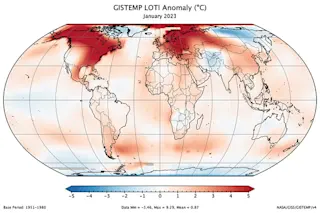La Niña typically casts a bit of a chill over the globe, and that certainly has been the case during its reign over the past three years. Yet despite the climate phenomenon's continuing influence, last month turned out to be one of the warmest Januarys ever recorded globally.
Moreover, even though La Niña exerted its maximum cooling effect in 2022, that year still entered the record books as being warmer than 2021. The reason, of course, was human-caused climate change.
Now, La Niña is fading away, and El Niño — which usually warms the climate — stands a 60 percent chance of emerging in the fall. So the globe could be on the verge of some very significant warming.
In their latest monthly climate analyses, NASA and NOAA have found that last month was the seventh warmest January in records dating back to the 1800s. "January 2023 marked the 47th ...














